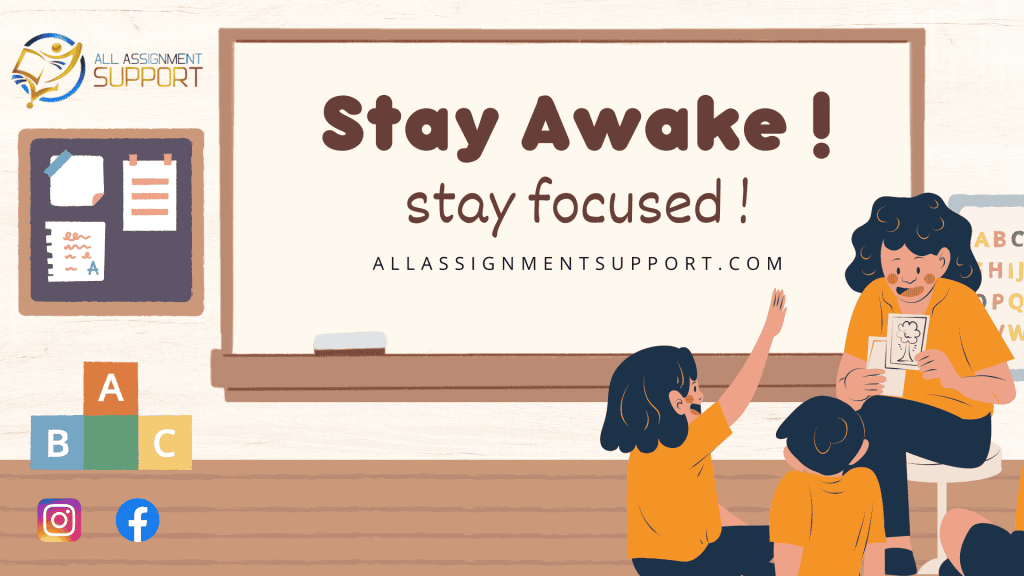Table of Contents
ToggleIntroduction
Ensuring you stay awake and attentive in class is vital for academic success. However, many students need help combating drowsiness and maintaining focus during lengthy lectures. Falling asleep in class hinders learning and negatively affects grades and the overall educational journey.
This article will delve into why students get sleepy in the course and present 20 proven techniques to help you stay awake and engaged during lessons. Discover how to stay awake in class with these tried and tested techniques to help you stay alert and interested during the studies.
Why Students Feel Sleepy in the Classroom?
As students, we’ve all encountered moments in the classroom when the struggle to stay awake becomes an uphill battle, and our eyelids feel heavy. To effectively address the issue of drowsiness, understanding the root causes is vital. This section will explore five common reasons why students often feel sleepy during lectures.
By shedding light on these factors, we can devise actionable strategies to not fall asleep in class and make the most of our educational experiences.
1. Lack of Sufficient Sleep
The foundation of staying awake and attentive in class is obtaining sufficient and restorative sleep. However, because of social responsibilities, late-night study sessions, and the appeal of internet diversions, students frequently find themselves entangled in the frantic environment of academia. They wind up getting little sleep, making them tired and less aware during the day.
Prioritizing and improving sleep patterns are essential for overcoming this difficulty. To give your body and mind the best chance of adequately regenerating, aim for 7-9 hours of unbroken sleep each night. The quality and length of your sleep may be significantly enhanced by creating a sleep-friendly atmosphere, adhering to a regular sleep schedule, and engaging in relaxation exercises before bed.
By recognizing the paramount importance of sleep and honoring its significance, students can equip themselves with the energy and mental clarity required to remain awake, engaged, and responsive in the classroom.
2. Monotonous Teaching Style
Lectures that lack interactivity and dynamic elements can be akin to watching a monochrome film – uninspiring and inducing drowsiness. Passive listening without opportunities for active participation can cause students to disengage mentally, paving the way for lethargy to take hold.
Educators play a crucial role in fostering a stimulating classroom environment. Instructors can captivate students’ attention and ignite their intellectual curiosity by integrating interactive teaching methods, such as discussions, group activities, and multimedia presentations. Additionally, incorporating real-life examples and storytelling can infuse lectures with relevance and resonance, making the learning experience more stimulating.
As students, actively seeking ways to participate and interact with the material can also invigorate your learning experience. Ask questions, provide your opinions, and maximize the chance to work with classmates throughout the class. By doing this, you get over your tiredness and develop a greater appreciation for the subject at hand.
3. Inactive Learning
Passive listening without actively engaging with the material can lead to a disconnection from the learning process. As the monotonous drone of the lecturer persists, minds can wander to distant realms, and the battle against drowsiness intensifies.
To counteract this:
- Adopt an active learning approach.
- Take notes during lectures, annotate your textbooks, and create summary sheets to reinforce essential concepts.
- Engage in reflective thinking and form connections between new information and prior knowledge.
Engaging in learning thoroughly arouses your cognitive abilities and improves your understanding.
Self-directed learning gives you control over your education, encouraging you to look for extra resources and perform independent research. Taking control of your education gives you the power to pay attention and be engaged in class.
4. Poor Nutrition
You may also apply the saying “you are what you eat” to attention. Unhealthy eating patterns or missing meals can cause blood sugar levels to fluctuate, leaving you tired and unable to concentrate.
Give importance to a well-balanced, nutrient-rich diet that contains whole grains, fruits, vegetables, lean meats, and healthy fats. To avoid a transient energy boost followed by a collapse, limit your intake of sugary foods and caffeinated beverages.
To maintain energy levels throughout the day, consider carrying healthy snacks like nuts, fruits, and yogurt. You can stabilize your blood sugar levels and keep your mind sharp during class by maintaining regular meal intervals.
By nourishing your body with the proper fuel, you ensure that the flame of vigilance burns brightly, dispelling the shadows of drowsiness.
5. Circadian Rhythm
The circadian rhythm, the body’s internal clock, is a critical factor in regulating our levels of alertness and drowsiness throughout the day. Our bodies naturally feel sleepy at certain times, typically in the late afternoon and early evening. Understanding your circadian rhythm can help you plan your day accordingly.
If possible, align your most challenging classes or study sessions with the periods when you feel most awake and alert. On the other hand, use the times when your energy levels naturally dip for shorter, less mentally demanding tasks.
Additionally, exposure to natural light during the day can help regulate your circadian rhythm. If the classroom setting permits, position yourself near a window to benefit from the stimulating effects of sunlight.
Acknowledging the reasons behind student sleepiness in the classroom opens the door to transformative change. To regain our attention, passion, and desire for learning, we must address the causes of tiredness. A classroom is no longer a place where we fight against drowsiness but rather a blank canvas on which we paint images of limitless curiosity and intellectual development.
Read Also: Things To Do When Bored In Class
20 Ways to Stay Awake in Class
The classroom, a bastion of knowledge and discovery, can also be a battleground against the creeping adversary of sleepiness. As we navigate the academic terrain, it is crucial to equip ourselves with a repertoire of proven strategies to stay awake and engaged.
We will explore 20 dynamic and effective tips, each a beacon of light amidst the sea of drowsiness. Let us unravel the mysteries of how to not fall asleep in class and how to wake yourself up in class, sparking a passion for focus and academic performance.
1. Get Sufficient Sleep
Aim for 7-9 hours of quality sleep every night to ensure optimal cognitive function and attentiveness during the day. Quality sleep is essential for concentration, information retention, and active engagement in the classroom.
Prioritize undisturbed rest to allow your body and mind to undergo vital restoration and consolidation. Sacrificing sleep for other commitments can negatively impact academic performance. Recognize the significance of sufficient and restorative sleep as the foundation for academic success and overall well-being.
2. Establish a Consistent Sleep Schedule
Maintaining a regular bedtime routine is essential for regulating the body’s internal clock and achieving a refreshed awakening. Adhering to a consistent sleep schedule synchronizes the circadian rhythm with the natural day-night cycle, improving sleep quality and enhancing daytime attentiveness.
Craft a bedtime routine encouraging relaxation, such as reading, mindfulness, or a warm bath, while minimizing electronic screen exposure to avoid sleep-wake cycle disruption. This routine fosters a sense of balance and harmony in daily life, empowering individuals to seize each day with renewed energy and focus.
3. Active Learning Techniques
Engaging in class discussions, taking notes, and asking questions is a powerful form of active learning that combats sleepiness in the classroom. Passive learning can lead to disconnection and mental fatigue, but actively participating in discussions and taking notes keeps the mind fully engaged.
By embracing active learning, students unlock their potential to stay awake and vibrant in class, transforming the pursuit of knowledge into a stimulating adventure.
4. Avoid Heavy Meals Before class
Choose light, balanced snacks to avoid post-meal drowsiness and maintain alertness in class. Heavy meals can divert blood flow to digestion, leading to lethargy. Opt for fresh fruits, yogurt, nuts, or whole-grain crackers for sustained energy and stable blood sugar levels.
Nourishing your body with wholesome foods enhances physical health and boosts mental acuity, empowering academic success. Prioritize smart food choices to fuel your body and mind for a productive and attentive learning experience.
5. Hydrate Throughout the Day
Staying hydrated is crucial for maintaining energy and focusing on the educational journey. Dehydration can gradually lead to fatigue and reduced cognitive function. Keep a water bottle handy and sip water regularly during class to counteract the effects of dehydration.
Hydration supports essential physiological functions, promoting alertness and mental acuity. By prioritizing hydration, you create an internal environment that fosters rejuvenation and sustained attentiveness, ensuring you remain alert and focused throughout the day.
6. Stand Up and Stretch
If you are wondering how to stay awake in class, this is one of the tricks to wake you up from drowsiness. To stay sharp in style, incorporate periodic standing up and stretching. When permitted by the instructor, these straightforward movements help counteract the decline in alertness resulting from prolonged sitting.
By pushing, you release muscle tension and enhance blood flow, revitalizing your body and delivering more oxygen to your brain. Additionally, stretching promotes flexibility and relaxation, aiding in stress management and directly influencing your attentiveness. Embrace these moments of renewal as opportunities to reignite your vigilance and maintain focus throughout the class, ensuring you make the most of your learning experience.
7. Utilize Natural Light
Sitting near a window in the classroom allows you to benefit from natural light, which plays a significant role in regulating your circadian rhythm. Natural light influences your sleep-wake cycle, and by exposing yourself to sunlight, you can synchronize your body’s rhythms with the external environment, promoting overall well-being and sustained energy levels throughout the day.
Furthermore, natural light acts as a mood enhancer, creating a positive learning atmosphere and reducing feelings of fatigue. Embracing the rejuvenating effects of sunlight empowers you to harness nature’s timekeeper and fortify your resilience against sleepiness in the classroom.
8. Participate in Physical Activity
Regular exercise is a powerful tool for maintaining focus and alertness in the classroom. Physical activity, such as brisk walking, jogging, or cycling, increases blood flow to the brain, delivering oxygen and nutrients that enhance cognitive function.
Exercise also stimulates the release of endorphins, which elevate mood and combat stress, contributing to attentiveness during lectures. By adopting a physically active lifestyle, students cultivate a resilient mind capable of enduring academic challenges with unwavering focus and energy.
9. Power Naps (When Appropriate)
A short power nap of 10-20 minutes can be a strategic tool to rejuvenate energy levels and revitalize the mind during breaks between classes. This brief restorative rest enhances alertness, memory consolidation, and overall cognitive performance.
However, adhering to the recommended duration is essential to avoid sleep inertia, which can lead to grogginess upon waking. By setting a timer and staying within the designated time frame, students awaken with increased clarity and readiness to tackle the next academic challenge with renewed focus and vitality.
10. Mindful Breathing
Deep, mindful breathing is a powerful technique to anchor focus and awaken the senses in a fast-paced academic environment. Intentional breaths bring in oxygen, activating the parasympathetic nervous system and inducing relaxation and mental clarity.
By incorporating mindful breathing exercises into daily routines, especially during weariness in class, students can banish lethargy and rekindle energy. Inhaling vitality and exhaling fatigue through deep breaths invigorates the mind and enhances cognitive prowess, allowing students to stay awake and fully engaged in the classroom.
11. Avoid Overheating
Dressing in layers is a strategic way to adapt to temperature changes in the classroom and prevent overheating-induced sleepiness. Temperature fluctuations can impact attentiveness, but by adding or removing layers as needed, students can regulate their body temperature for optimal cognitive function.
Being mindful of the classroom’s ventilation and air circulation further enhances wakefulness and creates a vibrant learning atmosphere. Embracing temperature awareness is crucial to stay vigilant and attentive during class, ensuring a conducive environment for focused learning.
12. Chewing Gum
Chewing gum may seem simple, but research shows it can combat sleepiness and enhance cognitive function. The act increases blood flow to the brain, providing oxygen and nutrients that invigorate mental clarity. Additionally, chewing gum stimulates saliva production, combating dry mouth associated with fatigue.
The chewing provides mild stimulation, keeping the mind engaged and preventing drowsiness. Be mindful of classroom policies, but if permitted, consider using this potent practice to stay awake and focused during class.
13. Stay Organized
Keeping study materials and class notes organized is a powerful tool to maintain focus and combat academic sleepiness. Organized notes create a conducive environment for attentiveness and minimize distractions.
Utilize color coding, highlighters, and bullet points to condense information effectively, transforming messages into a comprehensive resource that reinforces concepts. A tidy study area fosters mental clarity and prevents attention dispersal during lectures. Embrace organization as a critical strategy to stay engaged and alert, optimizing your learning experience in the classroom.
14. Interact with the Instructor
Active engagement with the teacher through questions and discussions enriches the learning environment and enhances attentiveness. Students become mentally invested in the material by asking questions and participating in class discussions.
This interaction fosters a sense of camaraderie in the pursuit of knowledge and deepens appreciation for the subject matter. Forming a connection with the instructor boosts motivation to excel in the class. Embracing the role of an eager learner awakens the potential to stay awake and captivated throughout the educational journey. Being an active participant in the classroom empowers students to maximize their learning experience and academic success.
15. Visual Aids and Mind Maps
Utilizing visual aids and mind maps is a potent strategy to combat sleepiness and enhance the learning experience. Visual aids, such as diagrams and illustrations, simplify complex concepts and improve comprehension, serving as memory anchors for easy recall.
Mind maps provide a comprehensive overview of the subject matter, fostering a deeper understanding of relationships between concepts. Creating these visuals during class engages in active synthesis and analysis, reinforcing the information presented. This process ignites cognitive faculties, promoting attentiveness and curiosity.
Embrace the potential of visual aids and mind maps to augment learning, leading to academic success and a vibrant educational journey where knowledge is actively assimilated and embraced.
16. Technology Management
In the digital age, technology offers valuable educational resources but can also lead to distractions during class. To stay awake and engaged:
- Adopt a responsible approach to technology use.
- Set boundaries and designate specific times for checking messages.
- Silence or minimize phone notifications during lectures.
- Use apps or extensions to block distracting websites.
By managing technology responsibly, you unlock your full attentiveness in the classroom, harnessing its potential as a powerful ally for productivity and engagement. Embrace technology as a tool for learning, rather than succumbing to constant digital diversion, and enhance your academic experience.
Read Also: 5 Tips for Writing a Stellar College Essay
17. Short Breaks
Taking short breaks is a strategic tactic during longer classes to prevent lethargy and maintain mental acuity. These intervals provide moments of renewal and revitalization, allowing your body and mind to disengage from the intensity of the class briefly.
Engage in physical movement like stretching or walking to stimulate blood flow and awaken your body and mind. Breaks also offer opportunities for social interaction, invigorating your spirit and fostering a sense of camaraderie with peers in the pursuit of knowledge. By incorporating short breaks into longer classes, you can stay energized, focused, and engaged throughout the academic session.
18. Optimize Your Seating
Optimize your classroom seating by choosing a seat that promotes good posture and provides a clear view of the instructor. Proper posture enhances cognitive function by improving blood flow and oxygen delivery to the brain.
Slouching or uncomfortable positions can lead to lethargy and distractibility. A clear view of the instructor fosters engagement with the material, as visual cues aid comprehension and attentiveness during lectures. By optimizing your seating, you create an environment conducive to unwavering attention, empowering yourself to embrace the educational journey with poise and focus fully.
19. Reduce Caffeine Consumption
Caffeine offers a temporary energy and focus boost, but excessive intake can lead to jitteriness and restlessness. A moderate amount, like coffee or tea, can enhance alertness and cognitive function. However, be cautious, as caffeine can dehydrate the body and contribute to fatigue.
To maximize the benefits, consume caffeine in moderation and avoid caffeine close to bedtime to preserve sleep quality. Balance is critical to harnessing the positive effects of caffeine while avoiding its potential drawbacks.
20. Prioritize Health and Nutrition
Eating a balanced diet and prioritizing self-care is essential for maintaining energy levels and focus. Nourishing your body with nutrient-dense foods provides sustained energy, keeping you attentive and engaged throughout the day. Self-care practices like regular exercise, sufficient sleep, and stress management support optimal cognitive function and mental clarity.
By honoring your body and mind through nourishment and self-care, you cultivate vitality that sustains you through academic challenges, prevents drowsiness, and awakens your senses to the joy of learning.
Concluding lines
Incorporating these tips into one’s daily routine instills a sense of empowerment, enabling students to conquer drowsiness, seize each learning moment, and maximize their academic potential. By awakening the reasons for the wonders of education and embracing the pursuit of knowledge with unwavering determination, students embark on a path of academic excellence and personal growth.
Through diligence, discipline, and the cultivation of healthy habits, the classroom becomes a realm of awakened minds, active curiosity, and enriched learning experiences.











